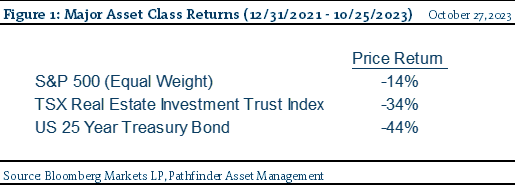Higher Interest Rates and Lower Asset Prices
This week, we highlight short and long-term interest rates and how much they have changed over the last 22 months. More importantly, we highlight the effect these changes have had on the three main asset classes: equities, fixed income, and real estate.
- We are now 22 months into the largest upward revision in interest rates in the last 40 years: The Bank of Canada has raised the short-term “overnight” interest rate from 0% to 5% and the US Federal Reserve has raised the overnight interest rate from 0% to 5.5%. Long-term interest rates have also risen meaningfully: the yield on a 30-year US treasury is now over 5%, compared to under 4% three months ago and under 2% twenty-two months ago. Long-term interest rates are more important when valuing long-term assets.
- The fundamental value of any asset is the cash that asset generates over its economic life, discounted at an appropriate interest rate. So, when the appropriate discount rate increases, the value of the asset decreases. In Figure 1, we highlight the effect higher interest rates have had on the three major asset classes.

- Real estate and fixed income have corrected more significantly than equities. We believe pricing for these assets were more frothy heading into the interest rate reset and this has led to a more meaningful correction in price.
“This means that” rising interest rates have had a meaningful negative impact on asset prices over the last 22 months. At a minimum, our mandates have been positioned with this risk top-of-mind. Our fixed income portfolio has maintained a very short duration and two of our equity-biased mandates are actually up during this time period. It is important to highlight that asset prices are down because they have been repriced for higher future returns: higher interest rates benefit long-term savers and investors IF you survive the time frame when they go up.
National Instrument 31-103 requires registered firms to disclose information that a reasonable investor would expect to know, including any material conflicts with the firm or its representatives. Doug Johnson and/or Pathfinder Asset Management Limited are an insider of companies periodically mentioned in this report. Please visit www.paml.ca for full disclosures.
Changes in Leverage. We are increasing the asset ceiling to 2.0 times the market value of equity for Pathfinder International Fund and Pathfinder Real Fund to be consistent with Pathfinder Partners’ Fund and Pathfinder Resource Fund.
*All returns are time weighted and net of investment management fees. Returns from the Pathfinder Partners’ Fund and Partners’ Real Return Plus Fund are presented based on the masters series of each fund. The Pathfinder Core: Equity Portfolio and The Pathfinder Core: High Income Portfolio are live accounts. These are actual accounts owned by the Pathfinder Chairman (Equity) and client (High Income) which contain no legacy positions, cash flows or other Pathfinder investment mandates or products. Monthly inception dates for each fund and portfolio are as follows: Pathfinder Core: Equity Portfolio (January 2011), Pathfinder Core: High Income Portfolio (October 2012) Partners’ Fund (April 2011), Partners’ Real Return Plus Fund (April, 2013), and Partners’ Core Plus Fund (November 2014).
Pathfinder Asset Management Limited (PAML) and its affiliates may collectively beneficially own in excess of 10% of one or more classes of the issued and outstanding equity securities mentioned in this newsletter. This publication is intended only to convey information. It is not to be construed as an investment guide or as an offer or solicitation of an offer to buy or sell any of the securities mentioned in it. The author has taken all usual and reasonable precautions to determine that the information contained in this publication has been obtained from sources believed to be reliable and that the procedures used to summarize and analyze such information are based on approved practices and principles in the investment industry. However, the market forces underlying investment value are subject to sudden and dramatic changes and data availability varies from one moment to the next. Consequently, neither the author nor PAML can make any warranty as to the accuracy or completeness of information, analysis or views contained in this publication or their usefulness or suitability in any particular circumstance. You should not undertake any investment or portfolio assessment or other transaction on the basis of this publication, but should first consult your portfolio manager, who can assess all relevant particulars of any proposed investment or transaction. PAML and the author accept no liability of any kind whatsoever or any damages or losses incurred by you as a result of reliance upon or use of this publication.